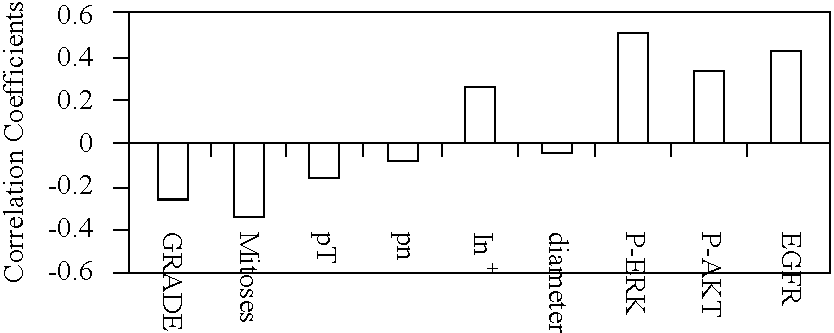Monoclonal antibodies specific for phosphorylated estrogen receptor alpha (Ser118) and uses thereof
a technology of estrogen receptor and monoclonal antibodies, applied in the field of antibodies, can solve the problems of uncontrolled growth and proliferation of cancerous cells
- Summary
- Abstract
- Description
- Claims
- Application Information
AI Technical Summary
Benefits of technology
Problems solved by technology
Method used
Image
Examples
example 1
Production of ER α Ser118 Phosphospecific Monoclonal Antibodies
[0039]Monoclonal antibodies of the invention were produced by immunizing BALB / C mice with the following peptide: CLMLLHPPPQLS*PFLQ (SEQ ID NO: 2), where S*=phosphoserine at position 118 of the ER α sequence (see FIG. 1). This sequence comprises residues 108 to 122 of human ER α with a cysteine on the N-terminal. Mice were immunized with 50 μg / 200 μl of this peptide in Complete Freund's Adjuvant, via intraperitoneal injection (IP). After three weeks, mice were further immunized with 25 μg / 100 μl of the peptide in Incomplete Freund's Adjuvant (IFA), via IP. Four weeks post second injection, mice were further immunized with 12.5 μg / 50 μl of the peptide in IFA, via IP. Three-and-one-half-months after the third injection, one animal, mouse #248D, was selected and further immunized with 12.5 μg / 50 μl of the peptide in sterile phosphate buffered saline, via intravenous injection in the tail vein.
[0040]Hybridomas were prepared a...
example 2
Detection of ER α Phosphorylation In Immunohistochemical Analysis of Human Breast Tumor Tissue
[0045]Immunohistochemical (IHC) analysis of paraffin-embedded tumor samples is the most common method for analyzing the pathology of a tumor. Determining the molecular pathology of the tumor may also be obtained through an IHC analysis of paraffin-embedded tissues. New cancer therapies targeted at the ER α receptor require that the patient have the ER α receptor and that the receptor is activated. Therefore, phospho-ER α (Ser118) monoclonal antibodies of the invention may be used to prescreen patients for inclusion in a clinical trial or before treatment with an ER α inhibitor, such as tamoxifen.
[0046]For IHC analysis, tissue acquisition, paraffin-embedding and sectioning were performed by Newcomer Supply, Middleton, WI. The obtained tissue sections were de-paraffinized with xylene and ethanol, then microwaved for 13 minutes in a 10 mM sodium citrate pH 6.0 buffer for antigen unmasking. Aft...
example 3
Tissue Microarray Analysis of Estrogen Receptor Serine 118 Phosphorylation and Correlations to Pathological Indices
[0048]A phosphorylation-specific ER α (Ser118) monoclonal antibody of the invention was used in a tissue array analysis to determine if phosphorylation at this residue correlated with any pathological indices such as tumor grade, tumor stage (pn and pt), lymph node status or nuclear status (mitoses). Tissue arrays provide a rapid method to screen a large number of patient samples under uniform conditions identical for all sections. In this experiment a breast tumor array consisting of 62 sections, each taken from a single patient, was analyzed. The corresponding pathological indices were also known for each patient.
[0049]The array was probed with the monoclonal antibody (clone 16J4) under standard immunohistochemical conditions as described above (see e.g. ANTIBODIES: A LABORATORY MANUAL, Chapter 10, supra.) and scored according to nuclear staining intensity and percent...
PUM
 Login to View More
Login to View More Abstract
Description
Claims
Application Information
 Login to View More
Login to View More - R&D
- Intellectual Property
- Life Sciences
- Materials
- Tech Scout
- Unparalleled Data Quality
- Higher Quality Content
- 60% Fewer Hallucinations
Browse by: Latest US Patents, China's latest patents, Technical Efficacy Thesaurus, Application Domain, Technology Topic, Popular Technical Reports.
© 2025 PatSnap. All rights reserved.Legal|Privacy policy|Modern Slavery Act Transparency Statement|Sitemap|About US| Contact US: help@patsnap.com



